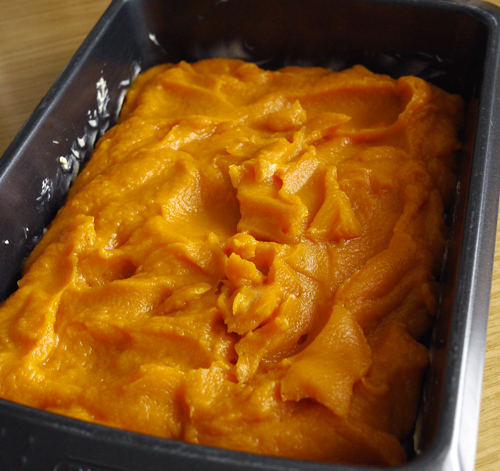Each year, eighty percent of the pumpkins grown in the USA are harvested in October. Commercially canned puree is probably the most familiar edible form of this popular autumn produce, however the mild, slightly sweet flesh of fresh pumpkin makes an excellent dish when baked, boiled, sauteed, steamed or microwaved. The pumpkin seeds, as well, may be toasted to create a marvelously tasty and healthy snack.
This article will discuss the process of selecting the proper cooking pumpkin and the technique for preparing homemade pumpkin puree.
Selecting and Storing Fresh Pumpkins
- For cooking, select the small ‘pie’ types, often called sugar, cheese or milk pumpkins – the ‘jack-‘o-lantern’ pumpkins are not as sweet and the flesh is tough and stringy. (If uncertain, ask your grocer to help select the proper variety.)
- Always select firm, sound pumpkins that feel heavy for their size. The rind should not have any blemishes or soft spots and a 2- to 3-inch stem should be intact.
- Fresh pumpkins may be stored in a cool, dry dark place for up to 2 months. Ideal temperature range for storage is 55 to 59F (12.5 to 15C). Do not store below 50F (10C) and do not store fresh pumpkin in a refrigerator or wrap in plastic.
How to Prepare Homemade Pumpkin Puree
The following recipe will yield a minimum of 1-3/4 cups of puree — equal to 1 (15-oz.) can of solid pack pumpkin puree. (Three pounds of fresh pumpkin will yield about 3 cups mashed cooked pumpkin.) Any leftover puree may be frozen – see freezing instructions below. Use this puree in recipes or substitute it in the same amount in any recipe calling for solid pack canned pumpkin.
1. Choose a 3 to 4 pound sugar (‘pie’) pumpkin for preparing puree. (Under no circumstances cook or eat a carved Halloween pumpkin as the cut surfaces breed bacteria.)
2. Preheat oven to 350F (175C).
3. Just prior to baking, rinse the pumpkin under cold water to remove any dirt or debris from the outside of the pumpkin; wipe dry with a cloth or paper towel.
4. Split the pumpkin in half and remove the seeds and stringy fibers by scraping the insides with a metal spoon. Discard fibers and save seeds for toasting, if desired.
5. Rub the cut surfaces of the pumpkin with canola oil and place the 2 halves (cut-side-down) in a roasting pan. Add 1 cup of water.
6. Bake in preheated oven until pumpkin flesh is tender when pierced with a knife (approximately 90 minutes).
7. Remove the pumpkin halves from the oven and place them on a cutting board or other flat surface to cool.
8. When cool enough to handle, scoop the baked flesh out of each pumpkin half with a spoon.
9. Puree pumpkin in a food processor fitted with a metal chopping blade or mash by hand.
10. Place the puree in a sieve lined with a paper-towel or coffee filter and set over a deep bowl. Let drain, stirring occasionally until the puree is as thick as canned solid pack pumpkin, approximately 1 to 2 hours. (Important: Do not allow cooked pumpkin to set at room temperature longer than two hours in the process of making puree.)
Note: Pumpkin may also be cut into chunks and steamed or cooked in boiling water until soft. Remove pulp from rind then mash or run through a food mill or food processor. Because this technique yields a more ‘watery’ puree, it is important to drain out moisture as mentioned above, or by gently warming in a heavy-bottomed saucepan to remove any excess water before use.
How to Preserve Pumpkin Puree
Homemade pumpkin puree freezes beautifully for later use.
To freeze:
1. Allow prepared puree to cool completely.
2. Measure puree into 1-3/4 cup portions and place in clean ridged freezer containers (leaving 1/2-inch headspace).
3. Label, date, and freeze for up to one year.
Cooking with Pumpkin Puree
Not only is pumpkin puree an excellent source of vitamin A, low in sodium and fat-free — it is also very versatile. Whether using homemade or commercially canned puree, it is an ingredient that may be used in preparing an endless number of pie, cake, cookie, muffin, sweet bread, pancake, creamy soup and elegant bisque recipes.
Why not try swirling some into a steaming bowl of cream of wheat cereal along with some maple syrup? Maybe consider perking up ordinary mashed potatoes by mashing in some pumpkin puree and sour cream. Just be creative and use your imagination – also keep in mind that most recipes that call for winter squash or sweet potatoes may be successfully prepare by substituting pumpkin.
Copyright 2005 Janice Faulk Duplantis
The Author:
Janice Faulk Duplantis
